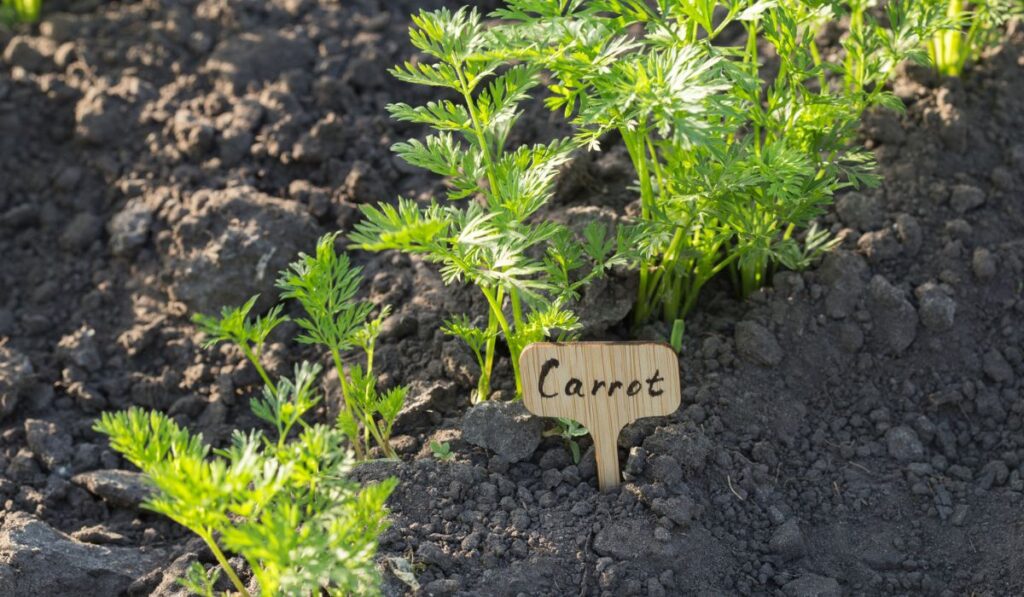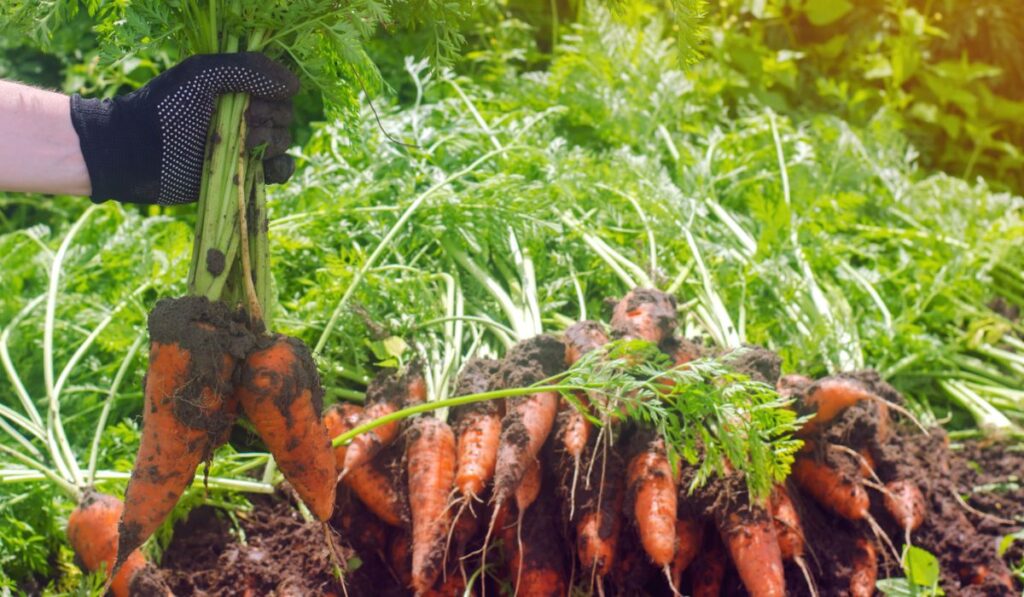If your garden has a nice corner waiting for a new crop, then it may be time to plant carrots! Carrots are one of the healthiest vegetables out there. These sweet, crunchy little orange powerhouses are rich in fiber, vitamins, and minerals. Plus, they’re low in calories and a good source of natural sugar. But when should you plant carrots?
For spring harvest, start sowing carrot seeds around four weeks before your last frost date. You can continue planting carrots every two to three weeks until the mean temperature rises above 70 F. For fall harvest, start sowing carrot seeds around 10 to 12 weeks before your first frost date.
Carrots seeds are directly sown into the ground and need to be kept moist until they germinate, which takes about 14 days. Ideally, you want to sow your carrot seeds in raised beds in little clusters and then thin them out to about three to five inches apart once they’ve sprouted. Let’s look at more tips on planting and growing carrots.
What’s the Best Season for Planting Carrots?

Carrot is a cool-season crop, which means it can tolerate frost and does best when planted in spring or late fall. In most parts of the country, the best time to plant carrots is four weeks before your average last frost date in spring.
Start preparing your carrot beds as soon as the ground can be worked in the spring. Then sow carrot seeds in clusters or broadcast them over the soil depending on your bed type. If you want a continuous supply of fresh carrots, plant a new batch every three weeks, starting four weeks before the average last frost date in your area.
You can keep planting carrots until the average temperature remains below 70 F. Any warmer than that, the overall growth and quality of the carrots will start to decline.
In warmer climates, you can get a second crop of carrots in the fall by sowing seeds in late summer. Look for hardy varieties of carrots that can tolerate heat and frost well, and start sowing your seeds 10 to 12 weeks before the average first frost date in your area.
When to Plant in Your Area?
As we mentioned, frost dates are the most common estimates to figure out when to seed. Frost is when the air temperature gets below 32 F. This can damage or kill many types of plants.
However, there’s no way to accurately predict when a frost will hit. Instead, look at the data from the last 20 to 30 years to estimate the average date of the last and first frost.
There are plenty of online resources that can help you find the frost dates for your area. Check out The Old Farmer’s Almanac page or the National Gardening Association.
Once you have your frost dates, count back four weeks before the last frost for spring planting and ten weeks before the first frost for fall planting. That will give you a broad range of when to start sowing carrot seeds in your garden.
Remember that these are just average dates. You should always keep an eye on the weather forecast and adjust your planting schedule accordingly.
Which Variety of Carrot to Plant?
The carrot is a plant that comes in all shapes, sizes, and colors. There are hundreds of different varieties. Here’s five of the most common carrots that are grown by home gardeners:
- Imperator: The classic “carrot-shaped” carrot you see in the grocery store. It has a long, tapered root that can grow up to 10 inches long. Imperators are sweet and crisp, and they grow fast under favorable conditions.
- Bolero: Similar in shape to the Imperator, but slightly shorter and stubbier. Boleros are also sweet and crisp with a deep orange color. They’re known for resistance to disease and pests and are good for storage.
- Nantes: Nantes isn’t tapered like other carrots. They’re more cylindrical and have a blunt end. These reddish carrots are exceptionally sweet, crisp, and very tender. Nantes carrots are low maintenance, so they’re a good choice for beginner gardeners.
- Danvers: Similar in shape to the Imperator, but they’re short and thin. They’re sweet, crisp, and come in various shades of orange. Danvers is short at just four to six inches, making them a good choice for gardeners with limited space.
- Chantenay: A short, stubby carrot known for its ability to grow in heavy, clay soils. Chantenays are picked early because they turn fibrous and woody if left in the ground too long. This makes them best suited for baby carrots or juicing.
Preparing the Soil for Planting Carrots
Carrots need loose, sandy, but well-draining soil to penetrate their long roots. Compacted or clay soils cause stunting. The same goes for rock or gravel soil, which makes the roots rough and misshaped.
If your soil isn’t ideal, you’d need to do a deep soil amendment before planting. This means working in organic matter like compost, leaf mold, or manure to loosen the soil and improve drainage and aeration.
First, remove any large rocks or debris from the soil. Then, use a spade or tiller to loosen the top eight to 12 inches of soil. Turn it thoroughly to break up any clumps and mix in the organic matter.
Rake the soil smooth, then work it into four to six inches high raised beds. This will improve drainage even further. Then you can sow the seeds on top in a single or double row, depending on the beds’ width.
How to Know When It’s Time to Harvest?
Carrots are ready to harvest 70 to 80 days after planting. But, you may want to start checking them at 60 days, depending on the climate and variety of carrots you’re growing. Smaller varieties like Nantes and Danvers should be ready to harvest much sooner than the larger carrots.
When ready for harvest, you’ll begin to see colorful carrot tops poking out of the soil. Gently loosen the soil around a few carrots with your fingers and check the diameter. If it’s around one-half to three-quarters inch, they’re ready to be pulled.
A ready-to-harvest carrot should easily come out of the ground with a gentle tug. Grab the foliage near the base, give a light push into the ground, then twist and pull. For some large carrot varieties, gardeners like to loosen the soil using a fork before pulling. You can also try that if you think there is no harm to any surrounding plants.
You can also check for the readiness of the crop by tasting a few carrots. Immature carrots will be bland and starchy, while overripe carrots will be woody and somewhat bitter. Carrots are perfect when they’re crisp and sweet.
Tips for Harvesting Carrots

- Don’t wait too long to harvest your carrots. If they’re left in the ground too long, they’ll begin to bolt, or flower and produce seed. Once that happens, the carrots will become fibrous and lose their flavor.
- Start checking for readiness about two weeks before the estimated harvest date. This way, you can enjoy your carrots at their peak of sweetness and flavor.
- Carrots gain more sweetness after a light frost. So, if you have a fall carrot crop, you may want to wait until after the first frost to harvest. Just be sure to cover your plants with a frost blanket or tarp if there’s a chance of freezing temperatures.
- Carrots can be harvested any time of day, but morning is best. The soil is cooler, and the carrots are less likely to wilt in the heat of the day.
- Immediately cut the greens off the carrots when you bring them in from the garden. The greens will continue to draw moisture and nutrients from the roots, causing the carrots to become dry and shriveled. You can add these carrot tops to the compost pile or use them as mulch for other plants.
- Harvest your carrots in stages. This way, you can enjoy homegrown carrots over several weeks or months without worrying about refrigeration.
Preventing Weeds and Pests
Carrot plants are susceptible to several common garden pests, including carrot rust fly, leafhoppers, wireworms, nematodes, and flea beetles.
Here’s a comprehensive list of carrot pests and how to prevent them:
- Carrot rust fly: The most common pests for carrots and other root crops. The larvae of carrot rust flies burrow into the roots, causing stunting, forked roots, and poor quality crops. To prevent this, use a floating row cover (on Amazon) or screen to keep the flies from getting to your plants. You can also try rotating your crops.
- Leafhoppers: These small, sap-sucking insects can cause yellow spots on carrot leaves. The damage is usually not severe enough to warrant treatment. That said, they can bring disease-causing bacteria into your garden. If you see leafhoppers on your plants, try spraying them off with water from a hose.
- Wireworms: Wireworms are the hard, shiny, and segmented larvae of click beetles. They feast on the roots and lower stems of carrot plants, causing stunted growth. The best way to prevent them is to rotate crops and practice good garden hygiene. When experiencing a wireworm attack, try traps baited with bran, oats, or wheat. Then destroy the worms you catch.
- Nematodes: These are tiny, parasitic creatures that live in the soil and feed on plant roots. They can cause stunted growth, yellowing leaves, and root knots. You can also try solarizing the soil to kill them.
- Flea beetles: These small, black, or bronze beetles eat away the leaves of carrot plants. To prevent them, use a floating row cover or screen. Mulch your plants with straw or grass clippings to keep the beetles from getting to the leaves.
- Aster Yellow Disease: This bacterial disease is spread by pests and can cause discoloration, bitter-tasting carrots, and stunted growth. The best way to prevent it is to remove the pests that spread it. When dealing with yellow aster disease, practice crop rotation and destroy any infected plants.
- Black Canker: This fungal disease affects the green tops and visible roots. The only way to prevent it is to grow resistant varieties.
- Weeds: When it comes to weeds, the best defense is a good offense. Carefully pull weeds from your carrot patch before planting, then handpick any remaining weeds when you begin thinning your carrot seedlings. Mulching with organic matter such as straw, leaves, or grass clippings can also save a lot of weeding time.
In general, always opt to plant hybrid varieties because they are more resistant to pests and diseases. Rotate your crops every two to three years, and inspect your carrot plants regularly, especially during hot, dry weather when pests are most active.
Look for early signs of problems such as chewed leaves or stunted growth. If you see any pests or diseases, take action immediately before they have a chance to take over your crop.
